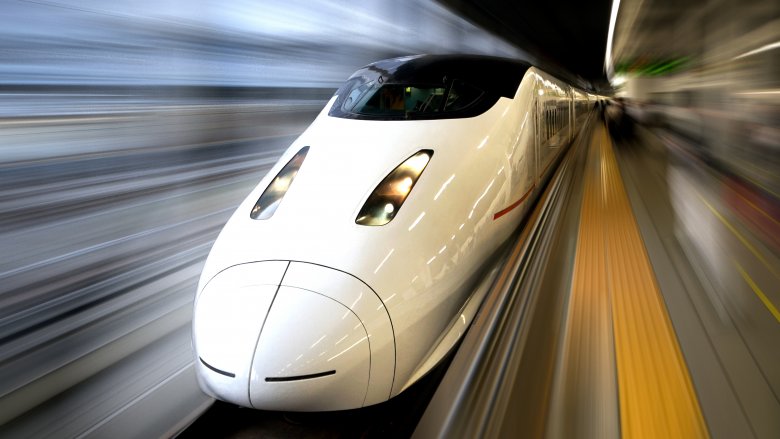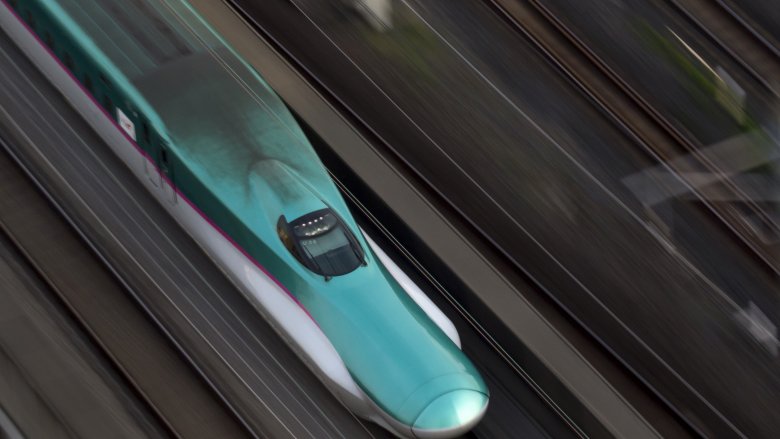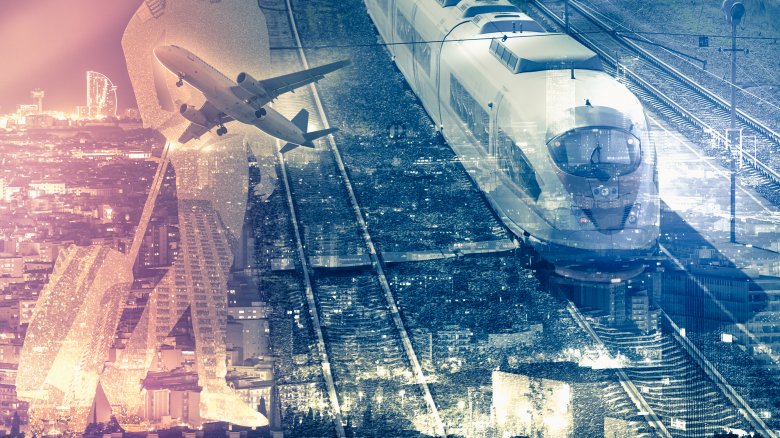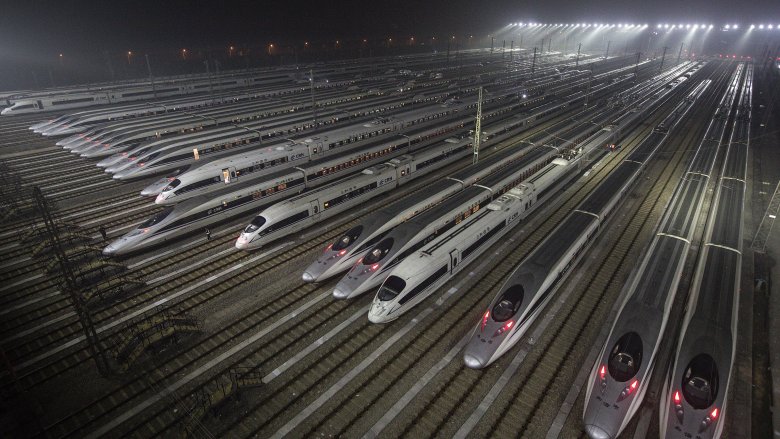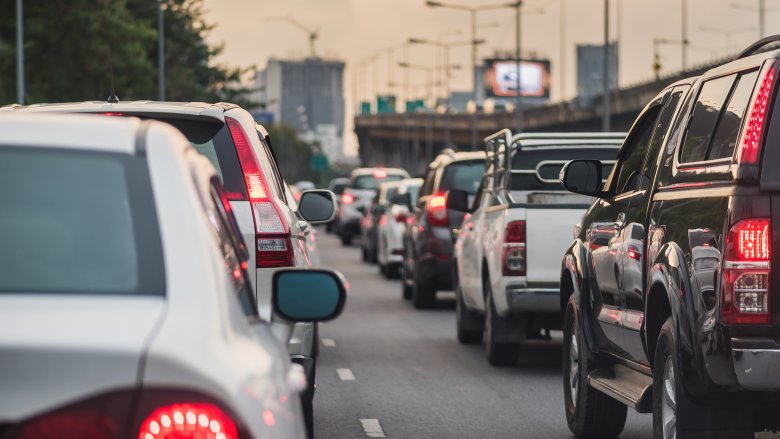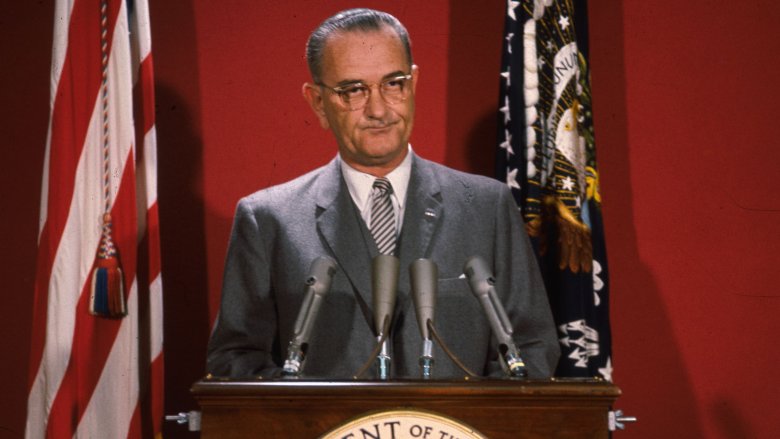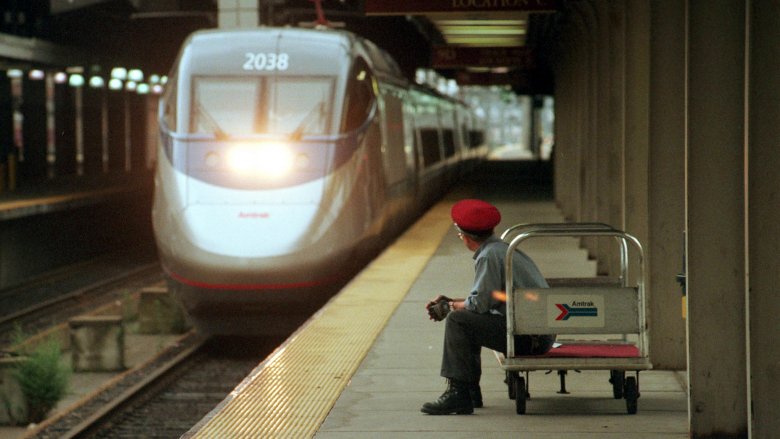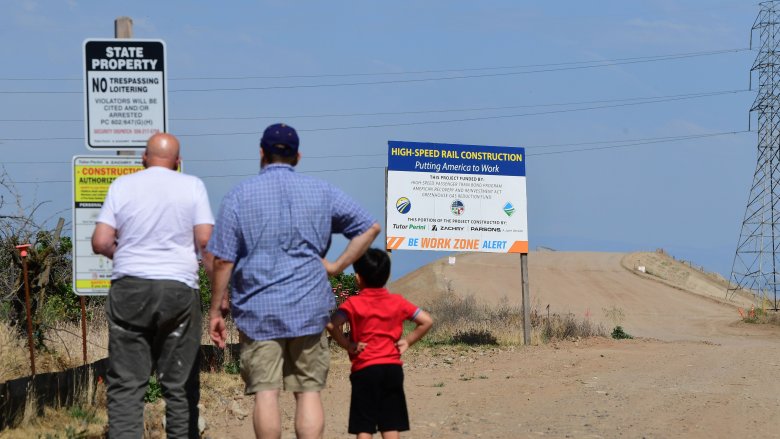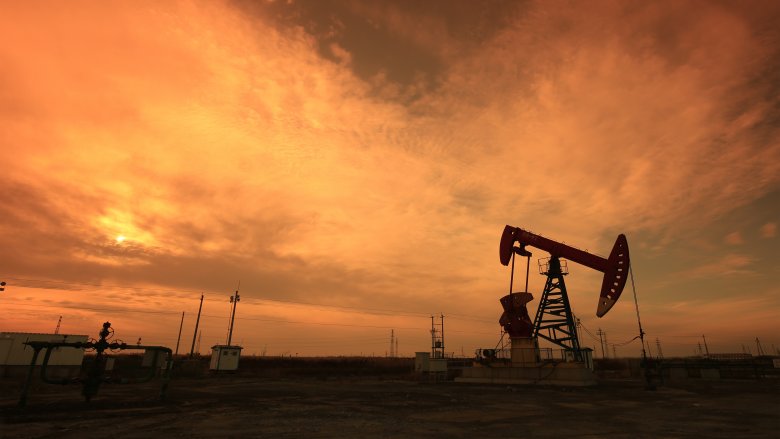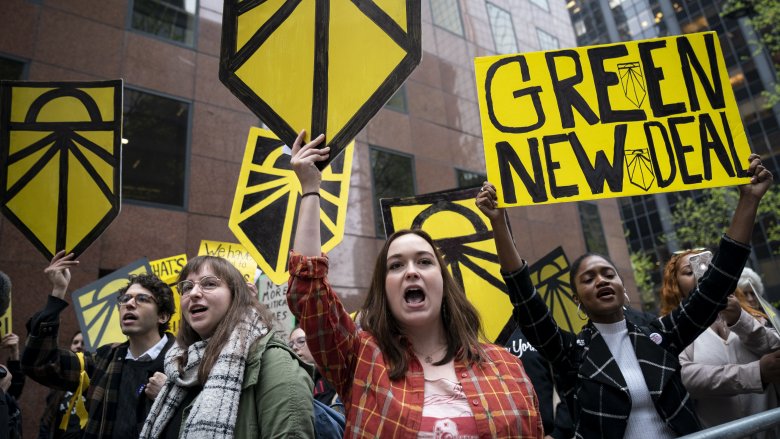The Real Reason The United States Has No High-Speed Rail Network
Like it or not, the United States has a big transportation problem. Yeah, cars are fun, but they're also expensive and inefficient, and every rattle under the hood is like a gunshot to your wallet. Planes? Sure, if you like paying for carrying on a snack that doesn't cost $12.95. Public transport in the U.S. is the pits, and if you want to travel a medium-range distance — say, between Boston and New York — for an affordable price, the options aren't pretty.
You know what would fix that particular issue? It's called high-speed rail, and though Americans have been taught to think of bullet trains as sci-fi futurism, they're just a mundane, everyday reality in some parts of the world. And it's been that way for decades, in some cases. While these speedsters zoom from country to country, the United States only falls further and further behind. Here's why the U.S. is struggling with high-speed rail.
Wait, so what is high-speed rail, exactly?
In the United States, everybody likes the idea of trains ... but U.S. trains are slow, clumsy, and stupidly expensive. Nobody wants to creep down the coast in an Amtrak, and can you blame them?
Meanwhile, countries like Japan, France, Spain, Saudi Arabia, and China run trains that whiz along so fast and so smoothly that, according to Vox, the average person prefers them to airplanes. That's because airports have to be situated a taxi ride away from big cities, and require all that security business. Train stations? Plant it right in the city center, baby. So if you want to travel a mid-range distance — say, 300 miles — a bullet train will get you there faster, cheaper, and more comfortably. No, they're never going to lay tracks across the Atlantic, where planes have a significant advantage. But for shorter distances, high-speed rail closes the gap.
Bullet trains are also dramatically more energy-efficient than planes and automobiles. The International Energy Agency reports that even though the rail sector carries 8% of the world's passengers, and 7% of global freight transport, it only represents 2% of Earth's transport energy demand. Even better, three quarters of passenger rail activity is on electric trains, making the rail industry the only form of transportation that is widely electrified today. So yeah, getting a country on rails is way cooler — and better for the world — than manufacturing billions of electric cars.
Are they really that fast?
Oh yeah, they are. Seriously, these things would give the X-Men's Quicksilver a run for his money. For example, California has spent years trying to build a bullet train between Orange County and San Francisco, according to Curbed, and if they ever finish the project, that speed demon could zoom through in less than three hours. For comparison's sake, a flight is about 90 minutes (just in the air, not counting TSA, taxi rides, etc.). Driving? Better block out the day, because Google Maps says it takes about seven hours when there's minimal traffic. (And there's almost never minimal traffic.)
That sort of distance, right there, is why high-speed rail is the future of public transport. And as futuristic as these things might sound to American ears, the real-life speeds charted by bullet trains are straight out of Star Trek. According to Business Insider, China's CRH380A breaks 300 mph. Germany and Japan both have trains that notch around 270 mph. So, this stuff isn't a utopian dream. The technology already exists!
The bullet heard 'round the world (except the U.S.)
Everybody's got that Instagram friend who backpacks to a different country every week. And when they go on (and on and on) to you about how travel is so much easier in other countries, they aren't lying. While the past few years have seen high-speed rail become increasingly hot in Asia and Europe, it's been around for a long time. How long? Try since 1964, according to Time magazine, when Japan's first Shinkansen started racing between Tokyo and Osaka. Bullet trains came to Europe in 1978, when Italy opened a line connecting Rome and Florence, and these science-fiction trains soon spread across Europe. According to Bloomberg, high-speed rails have seen an especially explosive growth in China, a country that now boasts not only the fastest trains, but also the largest rail network and the biggest plans for future growth.
Meanwhile, U.S. trains look like bumper cars sitting next to the Bugattis of the rest of the world. America's stagnated transit infrastructure now more closely resembles that of a developing country, as opposed to its peers, which is awfully weird for one of the wealthiest nations in the world.
Why high-speed rail in the U.S. would be great
If you don't think the U.S. has a transportation problem, well, clearly you've never been stuck in Boston's rush hour traffic. Talk about a headache! As Harvard Political Review points out, if you're an American citizen today, and you want to visit your family for the holidays, your two serious travel options — driving or flying — both suck and are massive fuel-wasters with a negative environmental impact. Yeah, sure, there's Amtrak, and if you don't mind spending two days moving at 40 mph, you can do that. Compared to other countries, though, the picture is embarrassingly dismal.
A high-speed rail network would broaden these options. While there'll always be a place for planes and cars, high-speed rail would revamp the country and connect places that are currently difficult to move between. HowStuffWorks argues that high-speed rail would cut smog, make cities more walkable, lead to less dependence on foreign oil, save lives — no matter good a driver you are, fewer cars equals fewer deaths — and even boost the economy, since it would create new jobs and mean less time wasted on traffic jams. Great! But...
The U.S. has been trying to fix this for a ridiculously long time
Uh, we've been working on high-speed rail for over 50 years, actually. Oof. Renewed efforts make headlines every once in a while and then projects the stagnate; it's all starting to feel like a high school science project that a student is still trying to finish up on their 25th birthday.
To be fair, right after Japan first introduced bullet trains to the world, the U.S. tried to hop onboard (you're welcome) from the get-go. All the way back in 1965, according to Marketplace, President Lyndon B. Johnson signed the High-Speed Ground Transportation Act. While construction began immediately — and did have some early success on the East Coast — the U.S. attempts ran into frequent mechanical problems, resulting in depleted funds by 1975. Not quite the grand achievement everyone hoped for. While the push for a proper high-speed rail has become more prevalent in the 21st century, and things seem to be amping up, it's not really clear that anything will be different this time around.
America's only high-speed rail is a slowpoke
The one great accomplishment of President Johnson's 1965 transportation act was that it did lead to the construction of the Metroliner, a so-called "higher-speed rail" that connected Washington D.C. to New York, according to Marketplace. Though the Metroliner only ran at 90 mph, which was pretty dismal compared to its Japanese competition, it was definitely a step in the right direction. Progress stopped there, unfortunately, and by 2006 the Metroliner was replaced by Amtrak's Acela Express line, which continues to be the closest thing the U.S. has to a bullet train.
Here's the thing about the Acela Express: Sorry, but it's a tortoise. In "bullet" terms, maybe a spitwad. Sure, it can occasionally speed up to 150 mph (which is still quite slow), but according to Fortune, the average speed on the Acela line is ... um, 68 mph. Yeah. Your 1999 Toyota Corolla can go faster than that when you just get a little distracted. Add in the fact that the Acela stops more frequently than the Metroliner did, and it results in America's fastest train actually being slower than it was a few decades ago. Not good. Sure, a tortoise gets where it's going, but in this case, those Eurasian hares just get there faster.
Oh boy, here comes the politics
High-speed rail isn't just achievable: It already exists. However, as with anything else in the U.S. today, the biggest obstacle in the way of American high-speed rail is politics. Speeding up the Acela Express, for example, would require billions in federal funding, according to Fortune. Good luck with that in today's polarized environment. Meanwhile, the political squabbles that have faced California's bullet train ambitions are now legendary, and not in a good way. While the concept of connecting the Golden State's biggest cities via bullet train is brilliant, Vox says the planning has been horrendous, between the addition of pointless and expensive stops, rushed construction, and bad financial decisions. The political battles got even nastier in 2019, when the Trump administration pulled $929 million in federal grants for California's high-speed rail, according to MSN.
The big problem? None of these dumb pitfalls have anything to do with high-speed rail itself. Bullet trains are a proven, established technology that reaps huge benefits across multiple sectors. Mess-ups like what happened in California have unfairly turned a great technology into a ridiculous tangle.
Automobile culture
The United States is absurdly obsessed with cars. Seriously, if you don't believe it, just think of the Fast & Furious movies. (If you're not familiar, the franchise is primarily an ode to Vin Diesel and Dwayne "The Rock" Johnson, but there's also heavy car symbolism hidden in most of the movies.) Due to generations of blaring advertisements and infrastructure built with cars in mind, Americans find gas-guzzlers more comforting than other modes of transportation, according to the Atlantic, even though automobiles are more dangerous, worse for the environment, and a pain in the neck for society at large. In the United States, your car is your friend. It's a rite of passage. This widespread car fanaticism is no accident, either. As Scientific American explains, America's love affair with cars was spurred by the concentrated marketing efforts of the automobile industry, who wanted pedestrians off the streets. By the time Eisenhower's Interstate Highway System was underway, well, cars were king.
The U.S. automobile obsession is an obstacle for high-speed rail dreams, according to Forbes, because cultural mores impact funding decisions. The U.S. has higher car ownership rates than other nations, so these countries are far more open to the idea of putting higher taxes on vehicles to cut demand — sometimes to the point of taxing purchasers an additional 150 percent on the car's base price. You think a tax like that would ever fly in the U.S.? Not in this lifetime.
However, this isn't even the biggest reason the U.S. has no high-speed rail network. There's a bigger (and wealthier) monster in the wings.
Don't fall for the lies: Americans DO want high-speed rail
Here's the thing. Lots of big companies will tell you that Americans don't care about high-speed rail, and they often blame automobile culture. However, surveys from the American Public Transportation Association tell a different story. A 2015 study found that if bullet trains were available, nearly two-thirds of surveyed Americans (63 percent, to be precise) would be happy to use them — and when people were informed of the cost and time-saving benefits of high-speed rail, that number increased a few points. Millennials want it even more, as at least 71 percent of the 18-44 crowd said they would like to ride bullet trains. (That bumped up to 76 percent when they learned about the other benefits.) Furthermore, high-speed rail enjoyed broad bipartisan support, and three quarters of survey participants supported making it easier for real estate developers to put amenities near high-speed rail stations.
So yes, average Americans do want high-speed rail, on both sides of the aisle. It's popular. It's proven. Why not?
The airline industry isn't a fan, and that's a problem
The real enemy foiling the launch efforts of high-speed rail in the United States isn't culture or public opinion, but rather, the billion-dollar industries that stand to take a hit. Want to guess which industry especially hates bullet trains?
Yep: airlines. As Harvard Political Review points out, the airline industry is understandably terrified that high-speed rail might cut into their market share. And it would, of course. Competition is supposed to be the key factor that makes the whole U.S. system work, but the airline industry pours buckets of cash into lobbying against high-speed rail, trying to ensure that the tracks never get built. This hostility has become particularly evident in Texas, according to the Texas Tribune, as the state's attempts to build a 200 mph line between Dallas and Houston have been smashed by aggressive attacks and lobbying by Southwest Airlines. CityLab reports that the airline went so far as to threaten leaving the Lone Star State entirely. Bullying, much? Considering that Southwest has been on the Fortune 500 for over two decades, it feels a little like crocodile tears. After all, nobody's trying to put these increasingly greedy airline industries out of business — just offering a worthwhile alternative.
There are other huge industries lobbying against bullet trains, too
You know what they say: Follow the money. The dearth of bullet trains in the U.S. isn't a coincidence, but rather, the result of gargantuan industries lobbying hard against their development through coordinated propaganda efforts and sometimes blatant lies. SF Gate reports that in 2008, for example, Amtrak spokesman Joseph Vranich referred to high-speed rail as "science fiction." Big oil doesn't like trains anymore than airline corporations, and neither does big highway, according to Manufacturing.
Most of the common negative talking points regarding high-speed rail have come from the Reason Foundation, a self-proclaimed "libertarian think tank" which regularly bashes bullet train efforts. They've heavily targeted California, which is at least a little understandable given the financial fiasco the whole thing has been there. But the Reason Foundation isn't the bastion of "free-thinking" it claims to be, considering the whole enterprise is funded by the Koch brothers, ExxonMobil, Chevron, Shell Oil, the American Petroleum Institute, Delta Airlines, and others. Thought isn't so free when it's paid for, eh? These corporations recognize that whenever Americans finally wake up to the benefits of electric trains that zoom along at 200 mph or more, nobody is going to put up with the increasingly draconian, classist baggage policies of most major airlines.
Basically, high-speed rail is an existential threat to big oil's market dominance, so whenever a project gains momentum, they pour billions of dollars into lobbyists, propaganda, paid politicians, and the Reason Foundation. That's the main reason the U.S. has no high-speed rail network, and this problem won't go away easily.
Despite pitfalls, high-speed rail is still pushing ahead
The lobbying issue isn't going to vanish overnight, and successfully implementing a high-speed rail network across the entire United States is going to take years — if not decades, depending on how future power struggles go. It ain't easy. Despite these obstacles, there are multiple high-speed rail efforts pushing ahead, according to Afar, fighting for a better, faster future. For instance, Virgin Trains USA (having acquired the smaller company XpressWest) is building an electric train that connects Las Vegas to the outskirts of Los Angeles, a popular route that they hope to make operational as soon as 2022. A similar project is underway in Texas — where they're working on a Houston-to-Dallas line that could even match Japanese bullet train speeds — as well as a Florida line from Miami to Tampa. The infamous California train seems to face new struggles everyday, but there is hope that they might someday pull it together. Fingers crossed.
After languishing on the back burner for decades, the past decade has seen newfound fervor for high-speed rail projects, particularly since investing in electric bullet trains is a key element in the Green New Deal, according to Vox. So don't rule out high-speed rail in the U.S. just yet. There's still a long way to go, but the future might get here some day.
